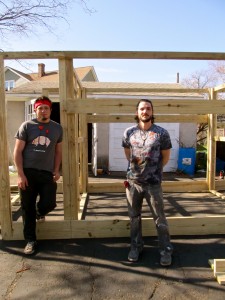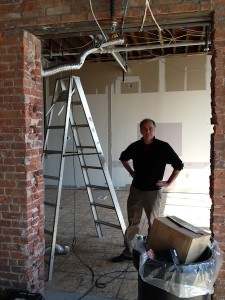Music & Public Life Intern Aletta Brady ’15 talks to photographer and filmmaker Joe McCarthy and woodcut artist, bookbinder, papermaker, and muralist Peter Albano about MiddletownRemix: Hear More, See More – A Festival of Art and Sound, taking place on Saturday, May 11, 2013 from 2pm to 5pm. The art/sound installation “Camera Obscura,” a temporary 16′ X 8′ “camera” commissioned for the festival, will be installed on the corner of Main Street and Grand Street by Mr. McCarthy and Mr. Albano. The installation will also be featured outside of the Usdan University Center at 45 Wyllys Avenue the week leading up to the festival, from Monday May 6 through Thursday, May 9, 2013.

In mid-April, I biked over to Peter and Joe’s house after I got off of work at the Center for the Arts. When I arrived, they were out in their backyard working on building their art installation that will be featured at MiddletownRemix: Hear More, See More – A Festival of Art and Sound on Saturday, May 11 from 2pm to 5pm. The installation is titled “Camera Obscura.” They happily showed me around the frame of the piece that they were working on, and invited me to join them around their coy pond for our interview.
Peter Albano is a graduate of the University of Hartford Art School where he studied printmaking, and Joe McCarthy studied photography and film in Boston and Los Angeles, before the two of them met in Middletown, and collaborated as artists on the Hog River Revival Project in Hartford. They described their project for the MiddletownRemix festival as “pinhole photography, just on a much larger scale—a pinhole camera that you can walk inside of. The sound element going on will [make it] a full sensory experience inside the camera”.
They had a lot of great things to say about the MiddletownRemix festival, and their role in it. Here are some highlights from our conversation:
Aletta Brady ‘15: Tell me about your art/sound installation “Camera Obscura” that will be displayed at the MiddletownRemix festival.
Joe McCarthy: We started thinking about the idea of creating this soundscape that was basically just taken, much like the [MiddletownRemix] project, from the streets. Nothing really created, more just arranged. And then we thought, “well, what kind of visual can match that sound element?” And, you know, the most bare bones, un-augmented camera is just a simple pinhole lens. There’s nothing to focus it, it is what it is, it’s just light. It use[s] the visuals from the streets of Middletown that are literally just what’s in front of your eyes. Its kind of like removing people from Main Street in order for them to more clearly view Main Street, or more clearly experience Main Street.
Peter Albano: One of the issues that we encountered was incorporating a sound element that highlighted the visual elements, because those are two completely different senses, and we landed on the idea of creating and taking one out of the environment, and that’s what the structure to walk into was, rather than any structure you just observe.
Aletta Brady ‘15: Why were you interested in creating an installation for the MiddletownRemix festival in particular?
Joe McCarthy: I think that we were both really excited that [the festival] is all about Middletown, like two blocks from where we make work, you know? ‘Cause the area that you choose to be in definitely has an influence on your work, and this sort of opportunity has allowed that influence to come to the front, which is healthy sometimes.

Aletta Brady ‘15: Tell me about yourselves as artists and your own personal journeys.
Peter Albano: I come from a much different background technique-wise than Joe. I’m much more of a drawer. I studied printmaking in college. I never dabbled in photography until the Hog River project. What drew me to this project was the scale of it, and the idea of getting it to work, making it work. It’s an endeavor. On a more broad scheme, I think most of our work revolves around the idea of highlighting the citizen that passes [and] community involvement. The Hog River project was a Hartford-centric project, and it revolved around the gathering of people and the sharing of information, and I think this project is a nice step up from there.
Joe McCarthy: All of my work, it just is a kind of way for me to break down something that I’m curious about. The subject matter is always on a personal level derived from me trying to reconcile my thoughts about one thing or another. Technically, the work I do has a lot to do with light, and in the Hog River project, that was all about [light], because there wasn’t any of it. That kind of became [the “Camera Obscura” project], where you have all the light in the world, and it’s all about limiting it and blocking it out and controlling the light.
Aletta Brady ‘15: What are you most excited about for Saturday May 11, the day of the MiddletownRemix festival?
Peter Albano: The flash mob dance [at 2:30pm in front of It’s Only Natural Market at 575 Main Street].
Joe McCarthy: I always get a kick out of being able to stand away from my work and watching how people interact with it, its always fun. Its cool to make something and there’s nothing you can do, it’s out there now, so all you have to do is just stand back and no one knows like, “oh those are the guys that made it.” So you can just stand there and watch someone, or go into the camera with someone, and really just pay attention to how that stranger interacts with this completely new thing to them. Its impossible to be objective. By the end of this camera, neither one of us will be able to say its good or bad, or if it worked or it didn’t, ‘cause we’re way too close to it, so I’m always curious about what the reveal on a finished piece of work is to a clean set of eyes.
For the complete MiddletownRemix festival schedule, and to capture, contribute and remix sounds from Wesleyan and Middletown using the free UrbanRemix app for iPhone/iOS and Android devices, visit http://www.middletownremix.org




